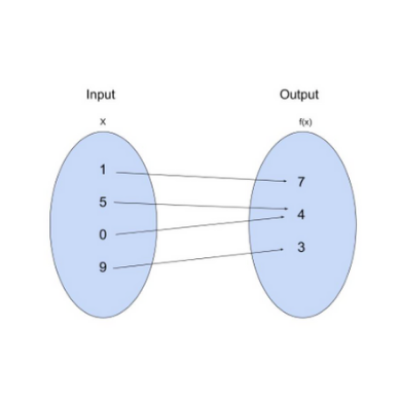What Are Functions?
Functions are one of the most integral parts of mathematics. While they may seem daunting and confusing, functions are actually quite simple. To help you get started, we’re going to break down exactly what functions are so that you can tackle them with ease.
So, what are functions?
Functions are a set of input-output pairs. You can think of a function as a machine. When you input a number, it will go through the machine and throw a new number back to you (the output).
The input is represented by “x”, while the output is represented by “f(x)” and the name of the function is represented by “f”. “f(x)” would mean “f” evaluated at “x”. The algebraic statement following f(x) is called the “rule of the function.” When you input an x value into the function, using the rule, a calculation will be done to produce an “f(x)” value. Simply put, you are evaluating for f(x). However in a function you won’t see the “f(x)” variable. Now this may seem very confusing, but remember that all a function is, is solving an equation when you are given a value for the x variable.
An Example of a Function
Now let’s look at a very basic example of a function and label its parts and understand how it works.
Problem:
f(x) = 2x + 1
The function name is:
f
The input is the:
x
Remember since y is the same as f(x) the y value in this function is:
f(x)
And the rule is:
2x+1
We are not going to go in depth on evaluating functions because that will be in the following lesson. However, solving them makes them easier to picture and understand so I will go through the steps to solve the same function as above.
A typical function problem would look as so:
Given the function: f(x) = 2x + 1
Solve for f(2)
Now let’s break this down.
We know that the function is: f(x) = 2x + 1
However we have never seen a value of “x” in the f(x) spot. This simply means that in this problem, x = 2. Remember the function machine, you can think of the “2” as the input into the machine.
Since we now know that x = 2, all we have to do is solve the function rule by plugging x into the function rule (2x + 1).
Solve:
x = 2
f(x) = 2(2) + 1
4 + 1
= 5
We were able to solve this function and receive an answer of 5. This means that once the “2” was input into the function machine, the machine output “5”. Therefore we can rewrite this equation as f(2) = 5.
Since f(x) for this specific problem is f(2), we can set f(2) equal to “5”.
An important thing to know about functions is that each input, meaning each “x” value has only one output, “f(x)”, however an output can be the same more than once.
This graphic can better help you understand this idea. Each input, or “x” value has only one output. For example when the input is one, then the output can only be 7. However when the input is 5 or 0 the output is 4. This is because when you are plugging a value of “x” in an algebraic problem, there will always be only one answer. This simply means that there is only one output associated to each input.
How Are Functions Used
Functions are used in equations to solve for a value. Remember, functions are just like algebraic problems you are used to. The only difference is that instead of solving for a variable, you are given the value of the “x” variable and a function and use these to solve for f(x).
Key Takeaways on Functions
Here are the key things you need to remember about functions in order to use them effectively:
Functions are a set of inputs and outputs in a mathematical sentence. The input is the “x” value and the output is the “f(x)” value.
There are four main parts of a function, the function name, the input, the output, and the function rule.
Each input in a function, “x” value can only have one output, “f(x)” value otherwise the function would not be considered a function.
When evaluating a function you are plugging in an “x” value into an expression and solving it. The answer is equivalent to f(x).
For more math lessons, check out our math series on algebra, expressions, radians, and our two part post on quadratic equations and how to solve them.
Want to try working with a free math tutor? Sign up for free math homework help through UPchieve now!


